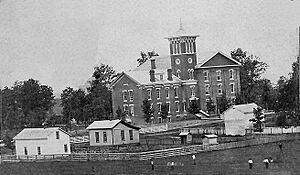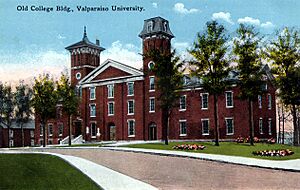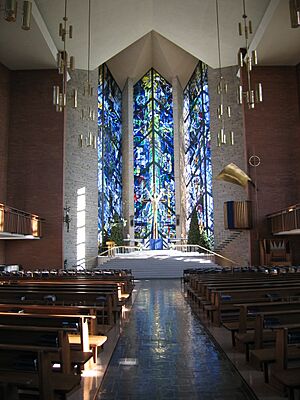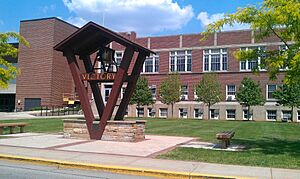Valparaiso University facts for kids
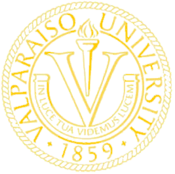 |
|
|
Former names
|
Valparaiso Male and Female College (1859–1871) Northern Indiana Normal School and Business Institute (1873–1900) Valparaiso College (1900–1906) |
|---|---|
| Motto | In luce tua videmus lucem (Latin) |
|
Motto in English
|
In Thy light we see light |
| Type | Private university |
| Established | 1859 |
|
Religious affiliation
|
Lutheran |
|
Academic affiliations
|
Space-grant |
| Endowment | $311.93 million (2024) |
| President | José Padilla |
|
Academic staff
|
190 |
| Students | 2,598 |
| Undergraduates | 2,142 |
| Postgraduates | 456 |
| Location |
,
U.S.
41°27′49″N 87°02′37″W / 41.46361°N 87.04361°W |
| Campus | Suburban, 350 acres (141.6 ha) |
| Newspaper | The Torch |
| Radio | WVUR-FM |
| Colors | Brown and gold |
| Nickname | Beacons |
Valparaiso University (often called Valpo) is a private university in Valparaiso, Indiana, United States. It is a Lutheran university with five different colleges. About 2,300 students attend Valpo, and its campus is about 350 acres.
The university is known for its Christian background. It has one of the largest chapels on a U.S. college campus. Valpo accepts most students who apply to study there.
Contents
History of Valparaiso University
Early Years: Valparaiso Male and Female College
In 1859, the people of Valparaiso wanted a college in their town. They raised $11,000 to help the Methodist Church start one. The school opened on September 21, 1859, with 75 students. It was one of the first colleges in the country where both boys and girls could study together.
Students paid $8 for each term, and room and board cost about $2 per week. The college taught young children and also offered higher-level courses. These courses included math, literature, history, science, and philosophy. During the Civil War, many students and staff joined the army. Financial problems caused the school to close in 1871.
New Beginnings: Northern Indiana Normal School
Henry Baker Brown reopened the school in 1873. He named it the Northern Indiana Normal School and Business Institute.
Becoming Valparaiso University
In 1900, the school changed its name to Valparaiso College. It became a university in 1906.
Valpo became known as "The Poor Man’s Harvard" because it offered affordable education. In 1907, it was the second-largest school in the nation. Only Harvard University had more students.
In 1914, the student magazine The Torch started. It became the university's weekly newspaper in 1915. Valpo began playing sports against other colleges in 1916.
Challenges and a New Direction
World War I and the death of President Brown caused problems for the school. In 1917, the university faced financial difficulties. In 1923, a fire destroyed the original Old College Building. The university had many money problems. President Horace M. Evans tried to get help from wealthy people and the state. He even considered selling the university to a controversial group, but the deal did not happen.
Finally, in 1925, the Lutheran University Association bought Valparaiso University. This group wanted to create a strong academic school. Valpo is still run by this association today. It is an independent Lutheran institution.
Growth and Development: The Golden Era
In 1940, O. P. Kretzmann became the university president. He led many important changes over 28 years. Valparaiso University bought more land in 1944, expanding its campus.
President Kretzmann helped enrollment grow from 400 to over 4,000 students. The university also became more academically challenging. Valpo created its Honor Code in 1943, which students still use today. After World War II, Valparaiso offered its first four-year engineering degrees.
In 1956, the Chapel Auditorium burned down. The university quickly rebuilt it, and the Chapel of the Resurrection opened in 1959. In 1958, Valpo even installed a small nuclear reactor for physics studies.
In 1967, President Kretzmann founded Christ College. This was an honors college, one of the first in the nation. The campus radio station, WVUR-FM, started broadcasting in 1960. In 1968, Robert F. Kennedy visited Valpo during his campaign. That same year, the university started international study centers in England and Germany.
In 1970, student protests led to a fire that destroyed Kinsey Hall. The first nursing class graduated in 1971. In 1976, Valparaiso University began competing in NCAA Division I sports.
In 1991, Valpo became home to the Lilly Fellows Program. This program helps young scholar-teachers. In 1998, the men's basketball team reached the Sweet Sixteen in the national tournament. In 2004, Phi Beta Kappa, a respected honor society, started a chapter at Valparaiso. In 2013, the university built a solar furnace for research. It is one of only a few in the U.S.
Recent Challenges and Changes
After 2015, Valparaiso University faced challenges with student enrollment. The number of students decreased. The law school closed in 2020. During the COVID-19 pandemic, the university had more financial problems. Some academic programs were stopped, and staff positions were reduced.
In 2021, the university closed its Confucius Institute. In 2023, the university decided to sell some paintings from the Brauer Museum of Art. This was done to help pay for dorm renovations. The museum eventually closed, and its staff positions were eliminated. In 2024, the university announced that more programs would be reviewed for possible closure.
Campus Life and Buildings
Old Campus Area
The Old Campus is next to the historic downtown area of Valparaiso city. It used to be home to the School of Law. Heritage Hall, one of the oldest buildings, was restored. The university's fraternities and the Kade-Duesenberg German House are also on Old Campus. The Martin Luther King, Jr., Cultural Center was here before it was destroyed by fire in 2009. The College of Nursing and Health Professions is located in Lebien Hall, north of Old Campus.
New Campus Area
Starting in the 1950s, the university expanded eastward. This area is now called the "new campus." It is the main part of the university today. Thousands of students live in nine dorms here. Most academic buildings are also in this area.
The Chapel of the Resurrection is at the center of campus. It is 98 feet high and a landmark in Northwest Indiana since 1959. It is used for worship services and other university events. A large addition to the chapel opened in 2015.
The Christopher Center Library, built in 2004, has over 500,000 books. It is a popular spot for students to study. The Valparaiso University Center for the Arts (VUCA) has performance spaces. Students use these for plays and exhibits. It also housed the Brauer Museum of Art.
Kallay-Christopher Hall opened in 2004. It is home to the Geography and Meteorology Department. It has an observation deck and weather labs. Schnabel Hall is next to it, housing communications students and the student radio and TV stations.
The Donald V. Fites Innovations Center was added to the College of Engineering in 2011. It has labs for advanced student research. The Physics and Astronomy Department has a large telescope for NASA research. It also has a virtual reality system for students.
The Arts and Sciences Building opened in 2012. It has classrooms and offices for the College of Arts and Sciences. The James S. Markiewicz Solar Energy Research Facility opened in 2013. Professors and students use it to study new ways to produce materials using less energy.
The Harre Union, opened in 2009, is a large student center. It has dining services, student organization offices, a bookstore, and entertainment areas. The Duesenberg Welcome Center, completed in 2013, is for visitors to campus. A new dorm, Beacon Hall, opened in 2014.
A "STEM village" is being built. It will replace the Neils Science Center. The first new building, the Center for the Sciences: Chemistry and Biochemistry, opened in 2017.
Academics and Learning
Valparaiso University has five main undergraduate colleges:
- Arts and Sciences
- Business
- Engineering
- Nursing and Health Professions
- Christ College
College of Arts and Sciences
This college combines liberal arts with career preparation. Students get hands-on research chances and internships. It offers over 70 programs in 21 departments. This college provides the core learning for all university programs.
College of Business
The College of Business is highly respected. It is accredited by AACSB International, a top business school accrediting body. It offers majors like accounting, finance, and marketing. Since 2018, it also offers a major in supply chain and logistics management.
College of Engineering
U.S. News & World Report ranked Valpo's College of Engineering as one of the best. It is among schools that do not offer doctorate degrees. About 90 percent of students finish their engineering degree in four years. The college offers service learning and research opportunities.
Christ College: The Honors College
Christ College is Valparaiso University's honors college. It was started in 1967 by President O. P. Kretzmann. It is for students who love learning and want to excel.
New students in Christ College take a special two-semester course. They read classic works from history, literature, art, and philosophy. This helps them explore important questions.
The college has fun traditions like the Freshman Production. This is a play created and performed by first-year students. The Oxford Debates are formal debates where students research and argue a topic. Students can also present their research at the Student Scholarship Symposium. Many students also study abroad through Christ College.
About 90 students join Christ College each year. These students also study in another college at Valpo. They can earn a major or minor in humanities.
Graduate Studies
Valparaiso University offers many master's and doctoral degrees. It also has graduate certificate programs.
Study Abroad Opportunities
More than one-third of Valpo students study abroad. This makes Valparaiso University one of the top schools for international study. Valpo offers over 40 study-abroad programs worldwide. These programs can last from a week to a full academic year.
Valpo has four global study centers. These are in Cambridge, England; Reutlingen, Germany; and San José, Costa Rica. Each center offers trips, courses on local culture, and housing. They are guided by a resident director. Valpo also partners with other programs. Students can study in places like Athens, Greece; Paris, France; and Osaka, Japan.
Reputation and Rankings
Valparaiso University is recognized in national rankings. In the 2025 U.S. News & World Report rankings, Valpo was tied for 204th among national universities. It was also ranked 45th for "Best Value Schools." Its undergraduate engineering program was ranked tied for 15th.
Washington Monthly ranked Valpo #149 for social mobility in 2021. It also ranked #182 for research and #291 for service among national universities.
Student Life
Student Body
Valparaiso University students come from many different places. Only about one-third are from Indiana. The rest come from almost every other U.S. state and nearly 50 countries. Over half of the students were in the top quarter of their high school class. About 77 percent of students return after their first year.
The university gives over $26 million in aid each year. More than 80 percent of students receive this help. It is based on grades, test scores, community involvement, and other factors.
Sixty-one percent of Valpo students live on campus. All students who are not seniors must live in residence halls. About 11 percent of students are Lutheran. Many students, about 75 percent, take part in faith-related activities. Valpo has over 100 student clubs and organizations. Half of the students play intramural sports. Over 1,000 students volunteer more than 45,000 hours each year.
Greek Life
More than 25 percent of Valpo students join fraternities or sororities. The university has ten national fraternities and six national sororities. In 2013-2014, these groups did over 10,000 hours of community service. They also raised $45,000 for charities. Most groups had a GPA above 3.0.
Honor Societies
Valparaiso hosts chapters of many major honor societies. These include Mortar Board National College Senior Honor Society.
Student Activism
Valparaiso University has a history of students speaking up for what they believe in.
Kinsey Hall Fire
In 1970, after some events at other colleges, Valpo students wanted discussions about violence. When talks with the university leaders didn't work, some students set fire to the empty Kinsey Hall. The building was destroyed.
Students Rebuild Engineering College
The College of Engineering exists today partly because of student action. In the 1930s, the engineering program was reduced. In 1948, students asked to bring back the four-year degree. The president said there wasn't enough space or money. Students offered to build a new facility themselves if the university would hire faculty. The president agreed. Students built the facility and raised money. By 1951, the college was again offering four-year degrees. This story even became a movie called Venture of Faith.
Student Media
Valparaiso University has several student media groups. These include WVUR: The Source (radio), VUTV (TV), The Beacon (newspaper), The Torch (newspaper), and The Lighter (literary magazine). These groups have won awards for their work.
Athletics
Valpo's colors are brown and gold. Their sports teams are called the Beacons. Most sports events happen at the Athletics-Recreation Center (ARC). Valparaiso has 18 teams and nearly 600 student-athletes. They mostly compete in NCAA Division I.
The football team plays in the Pioneer Football League. Men's swimming and men's tennis compete in the Summit League. The women's bowling team competes in Conference USA.
In 1942, Valparaiso University had the tallest basketball team in the world. They were called the "Valparaiso Giants." In 1998, the men's basketball team reached the Sweet Sixteen in the NCAA tournament. This was thanks to a famous last-second shot by Bryce Drew. Bryce Drew later became the head coach. Valpo also hosts the National Lutheran Basketball Tournament.
The men's soccer team won their conference championship in 2011. The men's basketball team also won their conference in 2011. The baseball and softball teams won their regular season and tournament titles. The bowling team also made it to the NCAA Championships. The women's volleyball team has had many successful seasons. In 2013, the men's golf team won their conference championship.
Valpo's NCAA Division I teams include baseball, basketball, bowling (women), cross country, football, golf, soccer, softball (women), swimming, tennis, track & field, and volleyball. The university also has cheerleading and club sports.
In 2021, Valparaiso changed its team nickname from "Crusaders" to "Beacons." This was because the "Crusader" name had a negative meaning for some people.
Notable People from Valparaiso University
Faculty Members
- Marcia Bunge: A theologian who studied children and childhood in religion.
- Faisal Kutty: A law expert, writer, and speaker known internationally.
- Gilbert Meilaender: An ethics and theology professor.
- Walter Wangerin, Jr.: An English and theology professor and award-winning author.
Alumni
See also
 In Spanish: Universidad de Valparaiso para niños
In Spanish: Universidad de Valparaiso para niños


